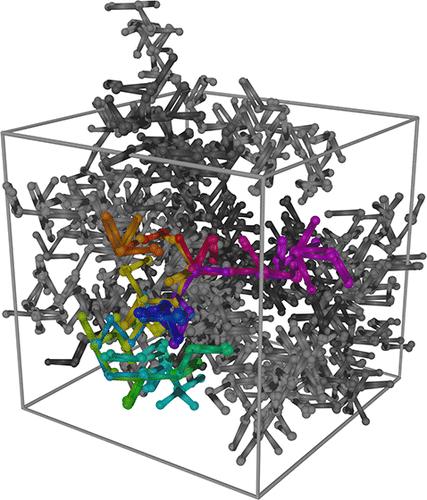双折叠随机支链环聚合物的涌现动力学
IF 5.2
1区 化学
Q1 POLYMER SCIENCE
引用次数: 0
摘要
随机分支双折叠环状聚合物的统计数据与RNA的二级结构、血小板DNA(以及细菌染色体)的大规模分支、单环聚合物通过一系列障碍迁移的构象以及真核生物染色体的构象统计数据以及皱褶、非连接环状聚合物的熔体有关。根据双折叠下的随机树状图是淬灭的还是退火的,以及树状图在空间嵌入中是否能进行无阻碍的布朗运动,双折叠环可以划分为不同的动态普适类。在局部,人们可以区分(i)在固定树周围的类似repton的质量传递,(ii)侧分支的自发产生和删除,以及(iii)树节点的位移,其中互补的环段在空间中一起扩散。本文采用动态蒙特卡罗模拟了一种合适的双折叠、随机分支环聚合物的弹性晶格聚合物模型,以探索上述局部模式在三种不同体系中不同组合所产生的介观动力学:理想的非相互作用环、自我避免环和熔体状态环。我们观察了环滑动的预期标度机制,双折叠环在障碍阵列中的动力学,以及rose -like树动力学作为极限情况。值得注意的是,在ν = 1/3的皱褶环中观察到的单体均方位移g1 ~ t0.4与在细菌染色体中观察到的亚扩散状态相似。在我们的分析中,我们关注的问题是不同的局部动力模式对涌现动力学的贡献在多大程度上是简单相加的。特别是,当所有三种类型的局部运动都存在时,我们揭示了相互作用环的动力学的非平凡加速度。在熔体情况下,环的渐近质心扩散主要是由环在障碍阵列动力学和树动力学的耦合所贡献的。此贡献与环权重成反比,并且与约束释放恢复类似劳斯动态的场景兼容。本文章由计算机程序翻译,如有差异,请以英文原文为准。

The Emergent Dynamics of Double-Folded Randomly Branching Ring Polymers
The statistics of randomly branching double-folded ring polymers are relevant to the secondary structure of RNA, the large-scale branching of plectonemic DNA (and thus bacterial chromosomes), the conformations of single-ring polymers migrating through an array of obstacles, as well as to the conformational statistics of eukaryotic chromosomes and melts of crumpled, nonconcatenated ring polymers. Double-folded rings fall into different dynamical universality classes depending on whether the random tree-like graphs underlying the double-folding are quenched or annealed, and whether the trees can undergo unhindered Brownian motion in their spatial embedding. Locally, one can distinguish (i) repton-like mass transport around a fixed tree, (ii) the spontaneous creation and deletion of side branches, and (iii) displacements of tree nodes, where complementary ring segments diffuse together in space. Here we employ dynamic Monte Carlo simulations of a suitable elastic lattice polymer model of double-folded, randomly branching ring polymers to explore the mesoscopic dynamics that emerge from different combinations of the above local modes in three different systems: ideal noninteracting rings, self-avoiding rings, and rings in the melt state. We observe the expected scaling regimes for ring slithering, the dynamics of double-folded rings in an array of obstacles, and Rouse-like tree dynamics as limiting cases. Notably, the monomer mean-square displacements of g1 ∼ t0.4 observed for crumpled rings with ν = 1/3 are similar to the subdiffusive regime observed in bacterial chromosomes. In our analysis, we focus on the question to which extent contributions of different local dynamical modes to the emergent dynamics are simply additive. In particular, we reveal a nontrivial acceleration of the dynamics of interacting rings, when all three types of local motion are present. In the melt case, the asymptotic ring center-of-mass diffusion is dominated by the contribution from coupling of the ring-in-an-array-of-obstacles dynamics with the tree dynamics. This contribution scales inversely with the ring weight and is compatible with a scenario in which constraint release restores a Rouse-like dynamics.
求助全文
通过发布文献求助,成功后即可免费获取论文全文。
去求助
来源期刊

Macromolecules
工程技术-高分子科学
CiteScore
9.30
自引率
16.40%
发文量
942
审稿时长
2 months
期刊介绍:
Macromolecules publishes original, fundamental, and impactful research on all aspects of polymer science. Topics of interest include synthesis (e.g., controlled polymerizations, polymerization catalysis, post polymerization modification, new monomer structures and polymer architectures, and polymerization mechanisms/kinetics analysis); phase behavior, thermodynamics, dynamic, and ordering/disordering phenomena (e.g., self-assembly, gelation, crystallization, solution/melt/solid-state characteristics); structure and properties (e.g., mechanical and rheological properties, surface/interfacial characteristics, electronic and transport properties); new state of the art characterization (e.g., spectroscopy, scattering, microscopy, rheology), simulation (e.g., Monte Carlo, molecular dynamics, multi-scale/coarse-grained modeling), and theoretical methods. Renewable/sustainable polymers, polymer networks, responsive polymers, electro-, magneto- and opto-active macromolecules, inorganic polymers, charge-transporting polymers (ion-containing, semiconducting, and conducting), nanostructured polymers, and polymer composites are also of interest. Typical papers published in Macromolecules showcase important and innovative concepts, experimental methods/observations, and theoretical/computational approaches that demonstrate a fundamental advance in the understanding of polymers.
 求助内容:
求助内容: 应助结果提醒方式:
应助结果提醒方式:


